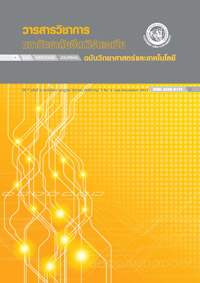มอเตอร์เหนี่ยวนำสองเฟส
คำสำคัญ:
มอเตอร์เหนี่ยวนำสองเฟส, อินเวอร์เตอร์ 3 กิ่ง, ชุดควบคุมสัญญาณดิจิทัล, two-phase induction motor, three-leg inverter, digital signal controllerบทคัดย่อ
บทความนี้นำเสนอมอเตอร์เหนี่ยวนำสองเฟส โดยการประยุกต์ใช้มอเตอร์เหนี่ยวนำเฟสเดียวชนิดหมุนด้วย ตัวเก็บประจุ (capacitor run) เพื่อใช้ในงานปรับความเร็วรอบ ด้วยการถอดตัวเก็บประจุที่ต่ออนุกรมกับขดลวดช่วย และแยกขดลวดหลักกับขดลวดช่วยออกจากกัน ในบทความนี้กล่าวถึงวงจรสมมูลของมอเตอร์เหนี่ยวนำสองเฟส เพื่ออธิบายถึงความสัมพันธ์ของสมการระหว่างขดลวดหลักกับขดลวดช่วยที่มีผลต่อการกระเพื่อมของแรงบิด วิธีการ นำมอเตอร์เหนี่ยวนำสองเฟสไปใช้งานโดยใช้อินเวอร์เตอร์ 3 กิ่ง เพื่อจ่ายแรงดันให้กับขดลวดทั้งสองชุดโดยมีมุมเฟส ต่างกัน 90 องศา ส่วนวิธีควบคุมใช้การมอดูเลชั่นแบบไซน์ ซึ่งทำให้ได้แรงดันเอาต์พุตมูลฐานสูงสุด 70.7 % ของ แรงดันบัสไฟตรง ที่ดัชนีการมอดูเลตเท่ากับ 1 และระบบทั้งหมดควบคุมผ่านชุดควบคุมสัญญาณดิจิทัล เพื่อความ แม่นยำและมีเสถียรภาพ
Two-Phase Induction Motor
This paper presents a two-phase induction motor, by applying the single-phase split capacitor induction motor (SPCIM) for adjusting speed, and by removing a capacitor from the auxiliary winding and separating main and auxiliary windings. This paper refers to the equivalent circuits of the two-phase induction motor to explain the relationship of equation between the main and auxiliary winding which has affected the production of torque. The application of the two-phase induction motor, by using the three-leg inverter is distribute a set of two-phase voltages 90-degrees out of phase to both coils. The method of control uses the SPWMs which have a fundamental output voltage 70.7 % of dc bus voltage at modulation index equal to 1, and overall system is controlled by a set of digital signal controller for the precision and stability.






